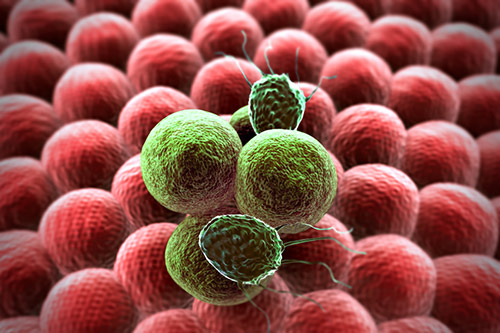
Source: Ugreen/iStock
Scientists at the University of Waterloo in Canada report that a new family of molecules that kill cancer cells while protecting healthy cells could be used to treat a number of different cancers, including cervical, breast, ovarian, and lung tumors. Their study (“In Vitro and In Vivo Studies of Non-Platinum-Based Halogenated Compounds as Potent Antitumor Agents for Natural Targeted Chemotherapy of Cancers”), published in EbioMedicine, shows that as well as targeting and killing cancer cells, the molecules generate a protective effect against toxic chemicals in healthy cells.
Cells can become cancerous when their DNA is damaged. Many different things can cause DNA damage, including smoking, chemicals, and radiation; understanding exactly what happens at the point of DNA damage can help scientists develop new cancer treatments. By studying this mechanism, the researchers could identify new molecules that selectively target cancer cells.
The team studied the process of DNA damage using femtosecond time-resolved laser spectroscopy. The technique is like a high-speed camera, which uses two pulses of light: one to start a reaction, and the other to monitor the way the molecules react. This technique let researchers watch how molecules interact in real-time, revealing how cells become cancerous.
Scientists have been using femtosecond laser spectroscopy to study biological molecules for decades, in fields called femtochemistry and femtobiology. More recently, this technique was fused with molecular biology and cell biology methods to advance the understanding of human diseases, notably cancer, and how therapies work. This potential new field is being dubbed femtomedicine (FMD).
“We know DNA damage is the initial and crucial step in the development of cancer,” said Qing-Bin Lu, Ph.D., lead author of the study. “With the FMD approach we can go back to the very beginning to find out what causes DNA damage in the first place, then mutation, then cancer. FMD is promising as an efficient, economical and rational approach for discovering new drugs, as it can save resources required to synthesize and screen a large library of compounds.”
Taking advantage of the FMD approach, Dr. Lu and colleagues discovered a new family of molecules called nonplatinum-based halogenated molecules (FMD compounds). These are similar to cisplatin, which is used to treat ovarian, testicular, lung, brain, and other cancers. However, while cisplatin is highly toxic, the new FMD compounds are not harmful to normal cells.
When these compounds enter a cancer cell, they react strongly and form reactive radicals, which cause the cell to kill itself. When they enter a healthy cell, the cell starts to increase the amount of glutathione (GSH) in the cell, which protects the cell against chemical toxins.
The researchers tested the molecules on human cells and in mice, and found consistent results. They treated various normal and cancerous human cells with the FMD compounds and tested them to see whether the cells were killed. They also tested the levels of GSH in the cells, revealing that the amount of protective molecule increased in the normal cells, while it decreased in cancer cells.
They then tested the FMD compounds on a range of tumors in mice, representing cervical, ovarian, breast, and lung cancers. They measured the extent to which the FMD compounds slowed down tumor growth, and found it was effective at slowing or halting the growth of all tumors.
“We're very excited about our discovery; we can see that the FMD compounds are just as effective as cisplatin in mice but without being toxic,” said Dr. Lu. “We believe that it could potentially be used to treat a very wide range of cancers, without making patients suffer the toxic side effects that some existing drugs have.”
“These compounds are therefore a previously undiscovered class of potent antitumor agents that can be translated into clinical trials for natural targeted chemotherapy of multiple cancers,” wrote the investigators.


